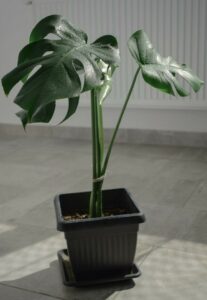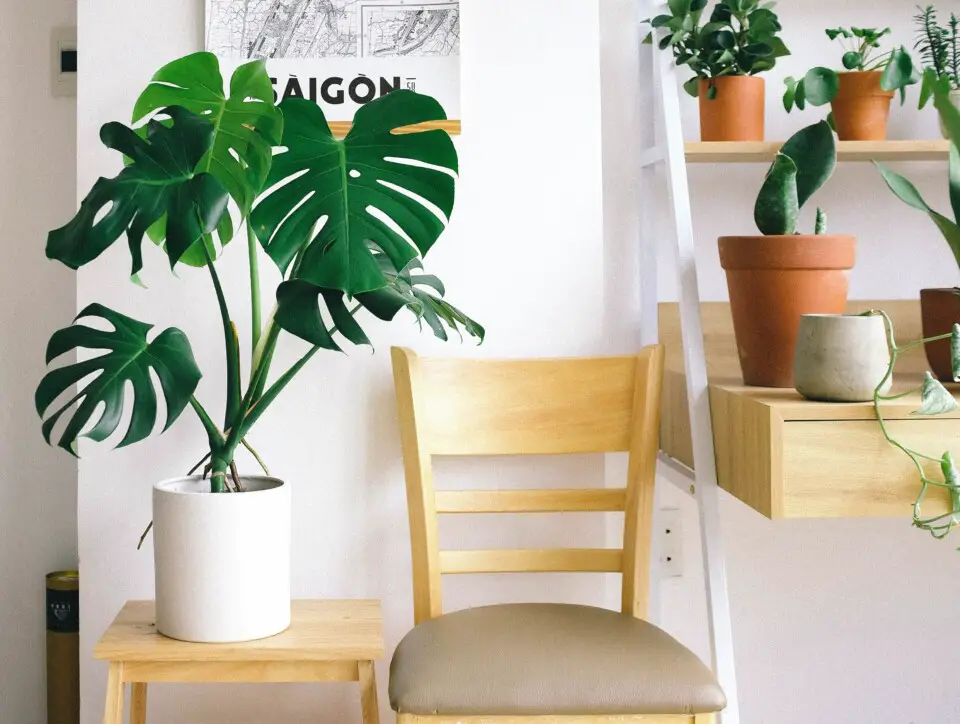Some links in the post are affiliate links and I get a commission from purchases made through some links found in the post.
When I got my peace lily, I remember being advised to allow it to be root bound before I repotted it. The words were slightly root bound, and that left me a bit confused.
How could a plant enjoy being devoid of growing space? And how could I, as a budding gardener, trust that this would be okay for the plant?
It turned out that the peace lily did, indeed, enjoy some cramped spacing as this helped it grow fuller.
And I remember a light bulb going off in my head – I should do this for all the other plants. Good idea, right? Wrong!
No sooner had I allowed my monstera to remain slightly root bound that the plant started slowing its growth and even showing signs of dying. Hurriedly, I repotted the plant, and it was soon back to its normal growth patterns.
And with that, I learned a valuable lesson. Not all plants like being root bound and the monstera certainly does not enjoy being deprived of growing space.
But that’s not all that the term root bound entails. I will get into what it means for your monstera to be in this state, how you can diagnose this problem, and how you can fix it. Let’s do this:
A monstera does not like to be root bound. Leaving it root bound will end up displacing the soil and creating a mat around the root ball.
This will hider the uptake of water and nutrients leading to stunted growth. When you notice your monstera is root bound, it is a good idea to repot it.
What Does Rootbound Mean?
 Growth patterns in plants are quite standard. The roots take up air, water, and nutrients and use these to feed the plant which, in turn, develops leaves that enable it to make food.
Growth patterns in plants are quite standard. The roots take up air, water, and nutrients and use these to feed the plant which, in turn, develops leaves that enable it to make food.
And this food gives it the energy to grow bigger. As the plant grows bigger, its feeding needs increase, and the roots must thus expand to meet this need.
So, it gets to a point where the plant roots need to expand and spread but they have already covered all the soil in the pot.
That’s what root bound means. It refers to a plant that is overall healthy and eager to grow that’s been bound to a constricted space.
The roots, at this point, start seeking new sections in the potting soil because they cannot penetrate the pot. And this is when they start wrapping themselves around each other.
If this is not enough, they move down towards the bottom of the pot where there is more space, and start circling it until there is no space left.
Unfortunately, the more space that the roots take up, the less room they leave for soil, water, and oxygen.
It makes it harder for the roots to keep feeding the plant because the nutrients available are not enough to absorb and keep the plant alive.
Eventually, the soil-to-root ratio becomes imbalanced. And without adequate soil, the plant cannot access water and nutrients.
The water you feed the plant goes straight to the drainage holes because there is no medium to retain enough of it to feed the plant. The best thing you can do for a plant at this stage is to split it or repot it as I have detailed in this guide.
How To Find Out If Your Monstera Is Root Bound
We have already established that a root bound monstera will face an array of issues. However, you should not disturb your plant by repotting or splitting it unless you are certain that it is root bound.
Doing so would only disrupt its growth, which is unnecessary in some cases. There are two steps to follow if you think your monstera’s roots need more room:
1) Assessing Physical Signs
One thing I have come to love about plants is how expressive they are. When a plant is not getting what it needs, it lets you know by exhibiting signs of distress.
And when a monstera is root bound and does not have enough access to water, air, and nutrients, it can show any of these signs:
1) The Drainage Holes Have Roots Coming Out of Them
When the room in the pot is insufficient to provide the roots with room for growth and nutrients, they start spreading out.
At first, they fill the spaces in the soil and even circle the bottom of the pot.
But when that still does not work, they start coming out of the drainage holes, which blocks the holes and prevents the roots from getting air.
After all, they do not have a soil medium to help them access this crucial growing requirement.
2) The Roots Start Growing on the Soil Surface
Besides coming out of the drainage holes, the monstera roots may start coming out on the soil surface.
It shows that the space in the soil is no longer enough, and the plant is trying to reach more nutrients. But the plant does not have access to nutrients growing on top of the soil and its growth thus takes a hit.
3) The Leaves Start Curling or Wilting
Whether the roots are growing wrapped around each other, out of the drainage holes, or on top of the soil surface, they will not have enough access to water.
And without it, the plant cannot sustain its cellular activities as it does not have enough turgor pressure.
Essential activities like evaporation and transpiration slow down and food production also reduces. The plant, which now lacks energy, starts drooping and you may notice its leaves looking lifeless.
4) The Plant Starts Showing Signs of No or Poor Growth
Every monstera requires adequate access to water, air, and nutrients. So, what happens when the roots can no longer access these key things?
They lose their function and soon enough, the absence of minerals and water takes a toll on the plant. It can either stop growing completely or start developing smaller and weak leaves.
This growth is not sufficient to provide adequate energy to maintain the plant’s growth and it will die if this goes unchecked.
5) The Soil Dries Up Fast
With an imbalanced soil to root ratio, most of the water you feed your plant will end up leaving the pot via the drainage holes.
That’s because the soil is not enough to hold on to the moisture. As a result, you will notice that you often water your monstera’s soil, yet it always seems dry after a day or two.
6) The Pot May Start Expanding
 Depending on the kind of material used to make your monstera pot, you may notice a change in its appearance. The pot can start expanding outwards or can even start breaking down.
Depending on the kind of material used to make your monstera pot, you may notice a change in its appearance. The pot can start expanding outwards or can even start breaking down.
It owes to the pressure from the roots. Bigger monsteras will exhibit more pressure owing to the strength of their roots.
Have you noticed such changes in your plant? If yes, it might be root bound. And below, I show you how you can gauge this for sure.
2) Examining the Plant’s Roots
While signs might seem like dead giveaways that your monstera is root bound, that is not always the case.
Sometimes, some of the signs above point to other issues affecting your plant. So, if the plant seems to have checked all the boxes above, you should then proceed with a physical exam as shown:
1) Water the Plant
You will have much better luck getting the plant out of the pot if the soil is loose.
Moreover, roots are quite tender, and handling them when dry can lead to severe damage which would hurt the plant’s growth chances once you moved it.
Ideally, you should water the plant the day before the inspection. If this is not feasible, you can water it at least three hours before touching the roots.
2) Cut the Protruding Roots
Your plant will not come out of the pot if its roots get caught in the drainage holes. So, you will need to find all the protruding roots and cut them off.
Please use a sharp and sterile knife to do this to avoid infecting the roots or bruising them and exposing them to pathogens.
3) Lay the Pot on Its Side
You might feel the urge to pull the monstera by its stem and leaves. However, even for a big plant, that would be quite damaging to its roots.
The best way to get the plant out is to gently ease it out of the pot. Lay the pot on its side and tap it gently to loosen the soil. Then gently tug on the plant to see if it comes out.
4) Help the Plant Out
If you’re using a plastic or glazed ceramic pot, you can easily secure the plant by tugging on it. However, some materials like stone and terra cotta present a surface on which the monstera roots can cling.
Thus, the roots may be stuck on the surface, and you will need to ease them out. The best way to do this is by using a long and serrated knife to wiggle the soil from the edges.
Then tap on the pot’s side again and remove the plant from the pot.
What happens if the plant won’t come out despite the above efforts? In that case, you will need to break the pot. Under no circumstances should you force the plant out of the pot by pulling on it, as this would only damage its roots.
1) Assess the Level of Compaction
How root bound is your plant? A slightly root bound monstera will have some of its roots wrapped around the root ball. However, one that has moderate compaction will have mats around the root ball.
In severe cases, the mats will be so thick that you will not even see any soil around the root ball.
If the case is severe, you have no option but to repot or split the monstera. But in slight and moderate cases, you can decide what feels right for you.
Please note that moderate cases only become worse over time. And this might be the time to move the plant.
You may also like: How to care for a monstera
Do Monsteras Like to Be Root Bound?
I have mentioned that you can choose not to repot slightly or moderately root bound monsteras. Does this imply that your plant can withstand being root bound?
Not at all. When you leave your monstera in a pot that is too small for its roots, you set it up for quite an uphill task.
The roots end up displacing the soil and creating a mat around the root ball, hindering the uptake of water and nutrients
As they expand, they can also get damaged because they have no room to grow, and this can hurt the plant’s growth.
However, there is an exception. If the plant does not show signs of distress despite being root bound, you can leave it as it is: Monsteras are quite adapted to living in small spaces.
And if they can access water and nutrients, they will keep growing. For example, a slightly root bound plant can keep growing for up to a year or more without showing signs of distress.
That’s because monsteras focus on vertical growth more than they do on digging into the ground. So, you may notice that the plant keeps growing despite the circling roots around its root ball.
But if you notice any of the warning signs (drooping, stunted growth, and mats around the root ball), you should consider the next step.
What To Do Next When You Find Out Your Monstera Is Root Bound

So, your monstera is severely root bound and needs a new home. What should you do? You have two options in this case: repotting the plant or splitting it.
Please note that young plants need repotting at least once a year to help them develop stronger roots that can sustain a healthy plant.
But mature monsteras only need repotting every two to three years. So, in the case of a young plant, repotting is the best option.
But a mature plant can withstand a lack of repotting and instead, make do with splitting. Please consider this when making your choice.
1) How to Split a Monstera
Did you know that the monstera produces calcium oxalate? This substance is quite toxic to pets and human beings.
As such, you should be careful when handling your monstera, especially during splitting, as you could come into contact with this toxic sap. If you ingest this sap, you could suffer signs of poisoning.
And if you touch it with your bare hands, you can get irritated. Thus, before handling your plant, I advise that you wear gloves to protect your skin.
And once you are done with the plant, wash your hands before touching anything because some sap may get on your skin.
Now, let’s get to what splitting entails. Have you ever wanted to fix a root bound plant but did not want to repot it?
After all, repotting is quite an engaging task that requires you to get another pot, fill it with potting soil, and get more space.
These are all limiting factors that could put you off from repotting your monstera yet again. If that’s the case, splitting might be a good idea.
How do you do it?
1) Wet the Soil in the Pot
You should not handle monstera roots when they are dry as this can damage them. And when this happens, it takes a while for them to start taking up water and nutrients to support the plant.
So, avoid this by wetting the soil around the plant roots to make it easier to tug the plant out of the pot.
2) Wiggle the Monstera from the Pot
I covered how you can do this under the examining your monstera All you need to do is tap the pot on its side as this loosens the soil. Then gently remove the plant from the pot.
3) Arm Yourself with a Sharp and Sterile Tool
You can use a knife or clippers for this task as these tools are sharp and will not bruise the monstera roots.
The goal here is to cut away the roots at the sections where they naturally divide so you can give rise to new split plants.
Each of these should have adequate roots and leaves to grow healthily. Please note that you must use a sterile tool; else, you will infect the roots with pathogens that can kill the plant.
4) Prepare a Fresh Potting Mix
While you will not be getting a new pot, you still need to give your monstera a good chance of survival. And the way to do so is by filling the pot with a fresh potting mix to half of its depth.
Then take the split plant and place it in the pot. You can now add the rest of the potting mix and water it to allow the excess water to drain from the pot.
What should you do with the extra plants? Splitting your monstera will give rise to a couple more plants. You can choose to plant these in separate potting mixes.
Or you can give them away to someone who wants to grow these species in their home. The split plant will not have trouble adapting to its new home as its roots will now have space to grow.
Give it a month and you will start seeing new growth. Of course, you must couple this with adequate nutrients and water.
2) How to Repot a Monstera
Repotting is the most common solution to root bound monsteras. It gives the plant more room to grow and enriches it with fresh nutrients for a growth spurt.
You must consider the size of the pot. While small pots are not good for the monstera, large pots also bring about issues of high water retention and root rot.
As such, the new pot should only be 2 or so inches bigger than the current one. Then proceed to repot it as follows:
- Wet the soil around the root ball a day before you repot the plant. It will make it easier to remove the plant from the pot and will reduce the damage to the roots.
- Wear gloves and wiggle the plant out of the pot. If you have trouble with this, please refer to my examining your monstera Do not forcefully remove the plant from the pot as this can hurt its roots and reduce the chances of the plant doing well after you have repotted it.
- Get rid of the soil around the root ball by scraping it off. That will make it easier to assess the root ball and gauge if any of the sections need to be removed. Use a sharp and sterile knife to cut off the damaged sections.
- Pour a fresh potting mix into the new pot to a third of its depth. Then take the monstera and place it in the soil before covering the pot with the remaining potting mix. Leave an inch between the top of the soil and the tip of the pot.
- Water the plant thoroughly and allow the excess water to drain from the pot.
The monstera will perk up a few days after it gets accustomed to its new home. Ensure it gets enough access to light, water, and nutrients.
What Containers Are Good for Monsteras?
 Monsteras are not very picky about the containers in which they grow when it comes to material. They can do well in plastic, stone, ceramic, or other containers
Monsteras are not very picky about the containers in which they grow when it comes to material. They can do well in plastic, stone, ceramic, or other containers
However, you must pay attention to the size of the pot. It should neither be too big nor too small. Instead, when your monstera becomes root bound, you must find a container that is 2 inches bigger than the last one.
That will enable the plant’s roots to grow into the extra space without running the risk of overwatering and root rot.
Of course, ceramic pots are always the best as they wick moisture away from the soil. But you can use any option if you follow the size guidelines.
What Soil Do Monsteras Like?
The monstera does well in well-draining and nutrient-rich soil. The soil should drain and retain moisture in equal measure to allow the plant to have access to water and air.
There are many monstera potting mixes available online. However, if you would like to make one, you can use equal parts of garden soil, peat moss, and perlite, or their equivalents. The goal is to create a mix with a medium-sized texture.
Final Thoughts
The general rule of thumb is to repot the monstera every year when it is young – and once every two to three years when the plant matures.
You should be safe if you play by this rule. However, it also helps to keep checking the plant for any signs it might be root bound. That way, you can give it a suitable environment and keep it happy.
Happy Gardening!


